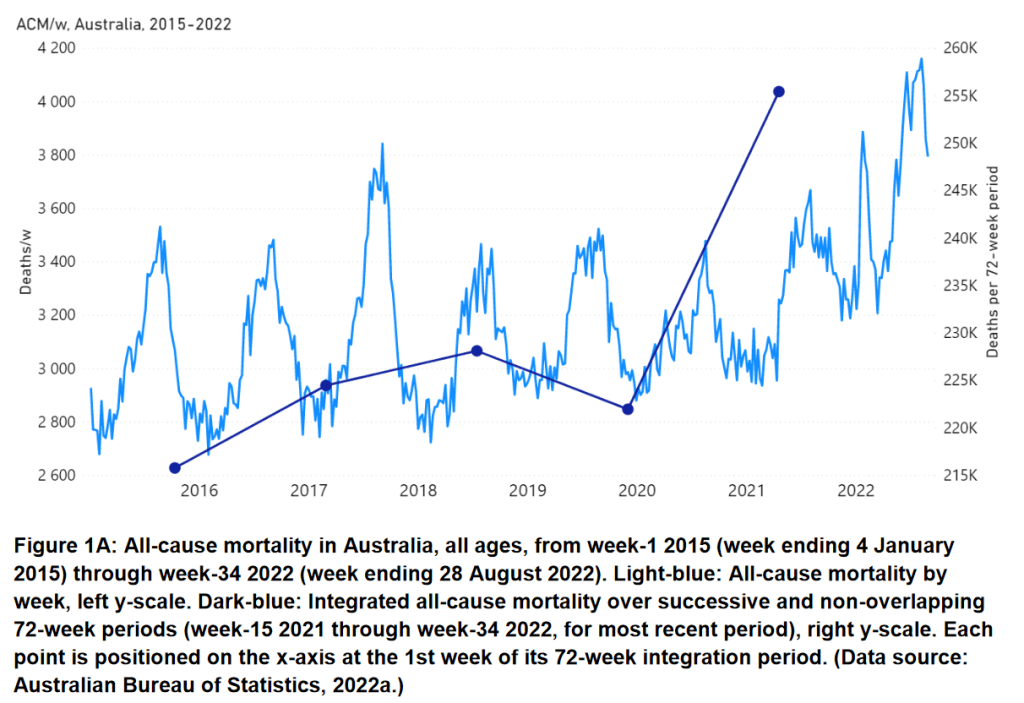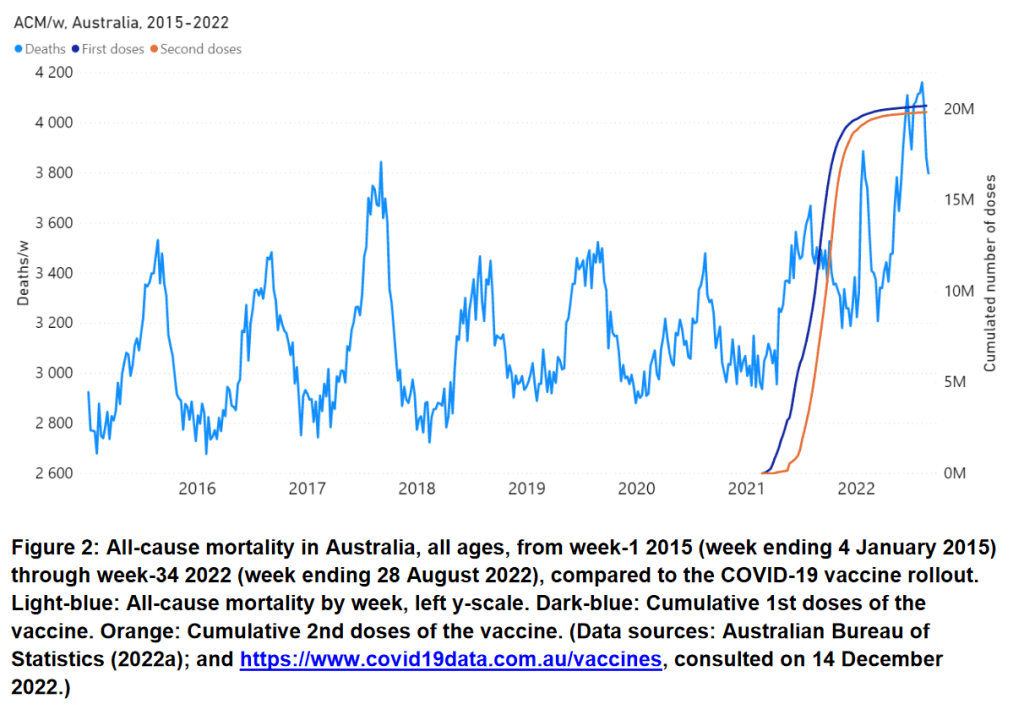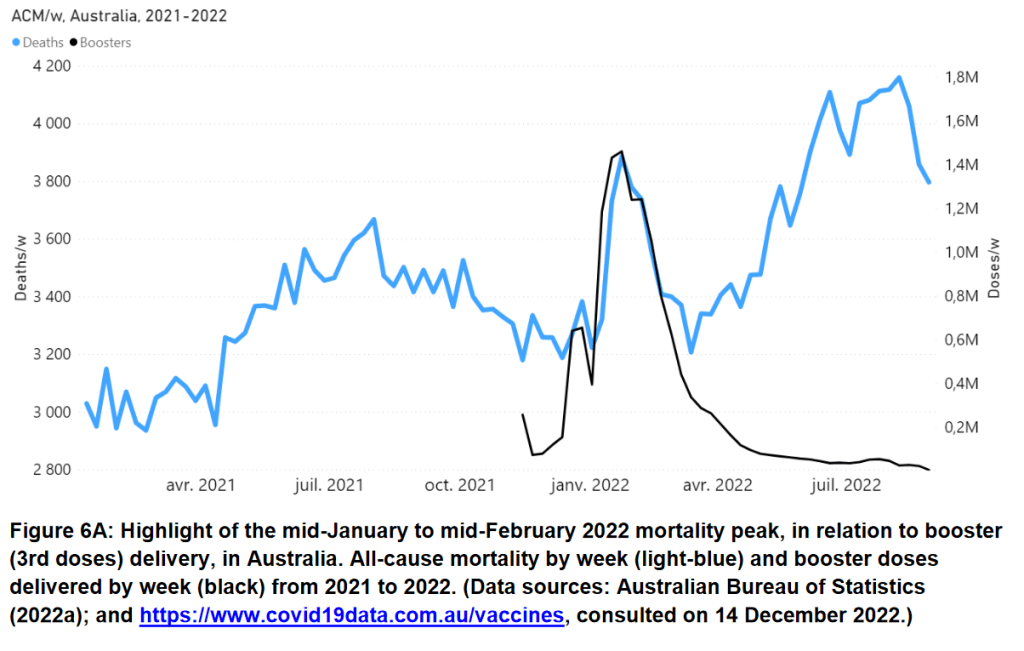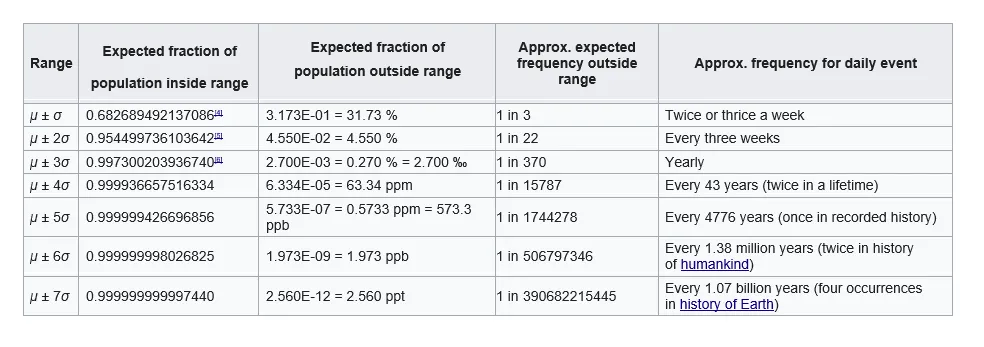The Great Australian Die-Off
Australia is in the grip of an unprecedented surge of excess deaths. Why doesn't anyone in power care?
As Australians prepare for our most divisive national public holiday, Australia Day, it’s time for me to revisit a topic that I last discussed around this time last year, in two posts, If the COVID-19 injections work, why are more people dying? Part 1 and Part 2.
That topic is the unexplained (or at least, officially uninvestigated) increase in excess mortality that has occurred since the roll-out of the RNA transfection agents commonly known as ‘COVID-19 vaccines’.
This excess mortality is evident in many, if not most countries around the world that pushed these transfection agents onto their populations. However in honour of the day on which this glorious nation was originally founded, as a penal colony on which the British Empire could dump the overflow of petty criminals generated by its rapid industrialisation, in this post I’ll be focusing on excess mortality in the land Down Under.
Let’s start with defining some terms that will be used throughout this article:
Mortality is the number of deaths for a given area during a given period.
Excess mortality refers to an unusual increase in mortality during a specific time period, in a given population.
Age-standardised death rate (SDR) is the death rate of a population adjusted to a standard age distribution. It is calculated as a weighted average of the age-specific death rates of a given population; the weights are the age distribution of that population. SDR is useful for comparing mortality in populations which have very different age structures from each other (for example, sub-Saharan African countries have proportionally more young people, while western European countries have more old people) and also for comparing mortality in a given population as its age structure changes over time.
The benefit of using excess mortality as a metric to assess the impact of both COVID-19 and the various policy responses to it is that it circumvents the ‘died with COVID vs died from COVID’ conundrum. While eminently qualified people could (and have) argued all day over whether infection with SARS-CoV-2 was a major, minor or insignificant contributing factor to the demise of people who are included in the ‘COVID death count’, total mortality leaves nothing to argue about. Either one is officially dead, meaning a death certificate has been issued and the death is registered with the jurisdiction’s central registry and included in national statistics, or one is not.
If a population was confronted with a deadly pathogen to which they had no immunity (which was the story we were all told about SARS-CoV-2), we would expect to see mortality increase over baseline at first, as those with the least resistance (the elderly and medically fragile) succumbed. Then, as the population gained immunity to the pathogen, mortality would eventually drop below baseline. This phenomenon is known as mortality displacement, or the harvesting effect: the deaths of many people with seriously compromised health are pulled forward by anything from a couple of days to a year or so, leaving fewer frail people to die in the subsequent year.
Furthermore, if a successful intervention was developed against the pathogen – such as a safe and effective vaccine that hastened the development of herd immunity and protected medically fragile people against serious illness, we would expect to see mortality decline even further below baseline, as the lives of those closest to death are prolonged somewhat by such an intervention.
Let’s see how these predictions stack up against measurable reality.
Total mortality
Notably, mortality was lower in 2020 – the year of the Deadly New Virus – than the average of the previous five years, by all measures, while it increased in 2021 and 2022. Specifically:
The average age-standardised death rate (SDR) for the years 2015-19 was 459.0 per 100,000 people, vs 424.5 in 2020 and 431.0 in 2021.
The SDR for the entire year of 2022 is not yet available, but the SDR per month in 2022 was above the baseline average from January through to August. The number of deaths that occurred between 1 January and 30 September 2022 (144,650 deaths) was a full 16 per cent above the baseline average. I’m sure I don’t need to point out that these additional deaths occurred after the vast majority of the adult population, and a substantial proportion of the child population, received at least two injections of a transfection agent that was supposed to ‘end the pandemic’.
The following graph tells the tale. Note the regular mid-year surges in mortality in 2015-2019, corresponding with the winter respiratory illness season; 2017 was a particularly severe flu year. Note also the departure from this pattern in 2020, with a series of pre-winter mortality spikes correlating with lockdown, and a blunted mid-year spike; the larger mid-year spike in 2021 compared to 2020; and the huge spike in mortality early in 2022 (a time of year when mortality is typically very low in Australia) followed by a massive mid-year surge.

COVID-attributed mortality
Turning our attention to deaths involving COVID-19 throughout the pandemic period:
In 2020, COVID-19 was the 38th leading cause of death in Australia. It was considered to be part of the causal chain of 898 deaths.
In 2021, 1122 deaths were attributed to COVID-19, making it the 34th leading cause of death.
Complete data for 2022 are not yet available, but between January and September 2022, 8160 deaths were certified by a doctor as being ‘due’ to COVID-19, making COVID-19 the fifth leading cause of deaths that occurred in that time period. (Interestingly, the Australian Bureau of Statistics (ABS) now lists a separate category of deaths ‘with’ COVID-19, that is, with COVID-19 certified on the death certificate as a contributing factor but not as the underlying cause of death. There were 175 such deaths in September 2022 alone.)
Not only is total mortality moving in the opposite direction to what we would predict if a) herd immunity was developing and/or b) a safe and effective vaccine had been deployed, but COVID-specific mortality is increasing too.
But why?
What’s driving the excess mortality?
To examine the impact of the transfection agents on overall mortality, Denis Rancourt and coauthors compared mortality data derived from the ABS in the pre-injection era (from the declaration of a pandemic by the World Health Organization on 11 March 2020 until the beginning of the injection roll-out in mid-April 2021), to the post-injection era.
They note that there was “no detectable excess all-cause mortality” in the pre-injection phase of the declared COVID-19 pandemic. However, all of that changed once the injection roll-out began:
“Starting in mid-April 2021, the all-cause mortality per week in Australia shows a sustained increase of >10 %, during which it never returns to its seasonal low value (of approximately 3,000 deaths/week) and attains highs of >4,000 deaths/week in June-July-August 2022…
Over the measured period of the step-wise increase in all-cause mortality (mid-April 2021 through August 2022; 14 % larger all-cause mortality than in recent pre-vaccination periods of same time duration; 62 million administered vaccine doses) there are 31±1 thousand excess deaths of all causes in Australia, whereas no excess deaths are detected in the prior 13-month period since a pandemic was declared (mid-March 2020 through mid-April 2021).”
Drilling down even deeper into the data, Rancourt et al found that the initial injection roll-out in 2021 was followed by surges in mortality, while the unseasonal mortality spike in early 2022 tracked the booster campaign to a remarkable degree:


Defenders of the transfection agents will no doubt argue that most of these excess deaths are due to COVID-19 itself, not the injections. There are several rebuttals to this claim:
Firstly, as Rancourt et al point out, “The excess mortality in the vaccination period (mid-April 2021 through August 2022) for Australia (all ages) is 31,000 (±1,000) deaths… which is more than twice the total number of deaths registered as being from or with COVID-19 (14,014 deaths, 1 January 2020 through week ending 29 August 2022.” That is, there were more than twice as many excess deaths in the 16 months after the injection roll-out began, than deaths that were associated with infection with SARS-CoV-2 (using absurdly loose criteria that are not applied to any other respiratory viral pathogen) throughout the entire 28.5 month pandemic period. Even if some deaths that were genuinely due to COVID-19 were not included in the toll (which is unlikely given the zeal of medicos to diagnose the condition), there is no way that all the excess deaths could be attributed to it, especially those in younger individuals with no risk factors for a severe case.
Secondly, the injections were supposed to protect against serious illness and death from SARS-CoV-2 infection, and public health authorities still continue to claim that they do exactly this. Yet excess deaths only began piling up after the transfection agents were inflicted onto the traumatised public, who were manipulated, cajoled and eventually bullied on pain of financial and social penalties into accepting these experimental treatments. Furthermore, there was a distinct shift in the demographics of those who died of/with COVID-19 during the Delta wave (July-December 2021), which coincided with both the roll-out of the transfection agents to younger people, and the imposition of workplace mandates and exclusion of uninjected people from social participation. Namely, people who died of/with COVID-19 during the Delta wave had a younger median age at death, and were more likely to be from a lower socioeconomic background (and therefore more reliant on maintaining employment).
Finally, the largest surges in excess mortality have occurred in 2022, during the Omicron wave, and yet the Omicron variant is universally acknowledged to be markedly less lethal than earlier variants.
As Rancourt and his coauthors put it,
“The question is unavoidable: Why would Australians suddenly (at the start of the vaccine rollout) start dying in excess of something mostly if not entirely other than COVID-19, after 13 months of a declared pandemic during which there was no detectable excess all-cause mortality?”
… and why would the deaths accelerate at the point where SARS-CoV-2 had transitioned to endemic status, becoming little more than a common cold virus?
(And no, the arguments that all those excess deaths are due to delayed effects of COVID-19, long COVID, lockdowns or reduced quality of healthcare are not tenable, as demonstrated by Martin Neil and Norman Fenton.)
Is this excess mortality really such a big deal?
The Australian Institute of Actuaries1 thinks so. In December 2022, they calculated excess mortality of 13 per cent using ABS data, which they described as “incredibly high”.
Spokeswoman for their Covid-19 Mortality Working Group, Karen Cutter, didn’t mince her words:
“Mortality doesn’t normally vary by more than 1 to 2 per cent, so 13 per cent is way higher than normal levels… I’m not aware [of anything comparable] in the recent past but I haven’t gone back and looked [historically]. They talk about the flu season of 2017 being really bad, and the mortality there was 1 per cent higher than normal. So it’s well outside the range of normal.”
Excess deaths in Australia ‘incredibly high’ at 13%: Actuaries Institute analysis of ABS data
Ms Cutter went on to list a number of possible contributing factors, including a harvesting effect after two years of low flu deaths, exacerbation of cardiometabolic disease by COVID-19 and reduced healthcare provision, all of which have been shown to be not connected to the increased excess mortality by Neil and Fenton and Rancourt et al.
Oddly, she dismissed outright any link between the experimental transfection agents and the 15 400 excess deaths that her institute calculated had occurred between January and August 2022, while admitting she can’t back her own claim:
“There is zero evidence that vaccines are causing these deaths as far as I’m concerned, but I cannot prove it.”
Excess deaths in Australia ‘incredibly high’ at 13%: Actuaries Institute analysis of ABS data
Indeed.
Ms Cutter called for an urgent investigation by the Australian Government into the unprecedented level of excess mortality in 2022. Her frustration and alarm were very evident:
“I feel like somebody should be doing something – but I don’t know who and what.”
Excess deaths in Australia ‘incredibly high’ at 13%: Actuaries Institute analysis of ABS data
Apparently it just doesn’t occur to well-meaning professionals like Karen Cutter that the government has no desire whatsoever to launch an investigation into the tsunami of excess deaths that has crashed down upon its population. Perhaps she should have a chat with the MD/PhD who writes on Substack under the pseudonym Ah Kahn Syed (say it out loud; you’ll get it) whose attempt to draw attention to the horrific excess mortality back in August 2022
… was met with deafening silence from government and its propaganda poodles:
“There were over 25,000 reads of that short article and not one media or government representative attempted to make contact to discuss it. I guarantee that they know that it was being discussed. Instead of enacting an urgent investigation, their response instead was to try to make the data look better and find some excuse.”
The good doctor also pointed out that the number of excess deaths represented a nearly 9 standard deviation (9-sigma) increase, and shared a handy-dandy chart from Wikipedia which illustrates how often you might expect to see events at each sigma level:
You’ll note that it stops at 7-sigma. I guess there’s not much point in going beyond that.
Ms Cutter naively insisted that the large volume of excess deaths could not possibly be due to the experimental transfection agents, because only 947 reports of death occurring in the context of these agents have been received by the Therapeutic Goods Administration (TGA), and of these just 14 deaths have been confirmed by TGA as likely related. However, as former AMA president Dr Kerryn Phelps recently pointed out, adverse events are vastly underreported because of the pressure placed on doctors to get in line with the public health narrative:
“Vaccine injury is a subject that few in the medical profession have wanted to talk about. Regulators of the medical profession have censored public discussion about adverse events following immunisation, with threats to doctors not to make any public statements about anything that ‘might undermine the government’s vaccine rollout’ or risk suspension or loss of their registration.”
But beyond the intentional underreporting, doctors often fail to recognise adverse reactions to vaccines, including the COVID transfection agents, because they do not understand the multitude of ways that these products can exacerbate existing pathologies, and cause new ones.
In the next post, I’m going to summarise some of the most well-studied mechanisms by which COVID injections can cause injuries and death.
For information on my private practice, please visit Empower Total Health. I am a Certified Lifestyle Medicine Practitioner, with an ND, GDCouns, BHSc(Hons) and Fellowship of the Australasian Society of Lifestyle Medicine.
Actuaries measure and manage risk using mathematical, statistical, demographic, financial and economic data. One of their cheerier tasks is to calculate the risk of death for particular groups of people. This is useful for governments, who need to plan for the provision of services to their population, and life insurance companies, who need to calculate premiums for customers such that they can turn a profit after paying out all claims.







Now what's that important line in Simon & Garfunkel's song, "The Boxer"?
"A man hears what he wants to hear and disregards the rest"...
Excellent post Robyn, it's the best summary I have seen regarding the escalating deaths in Australia. A 9 sigma level event is obscene, it should be the number 1 topic for everyone in govt and media. The fact that it isn't tells us a whole lot about their agendas. Time to start knotting ropes I reckon!